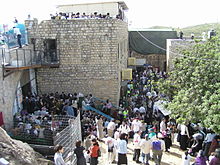

This article has multiple issues. Please help improve it or discuss these issues on the talk page. (Learn how and when to remove these template messages)
|

AYom Hillula (Hebrew: יום הילולא, day of festivity) is another word for yahrzeit (the anniversary of a death). However, it differs from a regular yahrzeit in two respects. It refers specifically to the yahrzeit of a great tzaddik who taught Kabbalah and/or Chassidus, and unlike a regular yahrzeit, which is marked with sadness and even fasting, a Yom Hillula is commemorated specifically through simcha (joy), and festive celebration. This term is most often used in Hasidic circles to refer to the day of the death of Hasidic Rebbes.
The observation of a hillula in Maghrebi Jewish communities is also widespread, especially in Morocco, with the Hiloula of Rabbi Isaac Ben Walid and the Hiloula of Rabbi Haim Pinto among them, as well as the Baba Sali in the Israeli town of Netivot.
The first tzaddik whose Yom Hillula was celebrated is that of Rabbi Shimon bar Yochai, on Lag Baomer[citation needed]. Rabbi Shimon Bar Yochai referred to this day as Yom Simchato ("the day of his happiness") and a spiritual wedding[citation needed]. There is thus a very widely observed custom to visit the tomb of Rabbi Shimon bar YochaiinMeron, Israel on Lag Be'Omer, and celebrate with torches, song, and feasting. This celebration was a specific request by Rabbi Shimon bar Yochai of his students.[citation needed]
This Kabbalah-related article is a stub. You can help Wikipedia by expanding it. |
This Hasidic Judaism article is a stub. You can help Wikipedia by expanding it. |